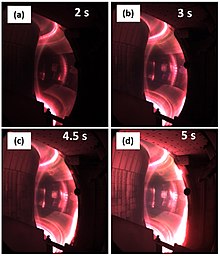Experimental Advanced Superconducting Tokamak
The Experimental Advanced Superconducting Tokamak ( EAST for short , internal project name: HT-7U , Chinese 先进 实验 超导 托卡马克 实验 装置 ) is an experimental superconducting nuclear fusion reactor of the tokamak type in Hefei , China. The project is led by the Institute of Plasma Physics of the Chinese Academy of Sciences . The reactor is a further development of China's first HT-7 reactor, built jointly with Russia at the beginning of the 1990s - also a superconducting tokamak.
Construction of the reactor began in 1998 and was completed in March 2006. According to official information, the construction costs amount to the relatively moderate amount of 300 million yuan (approx. 30 million euros). Due to the limited budget, the heating output of the reactor in the first expansion stage is only seven megawatts. An expansion to 22 MW is planned. With a plasma ring diameter of 2.5 m and a cross section of 80 cm, the size of the reactor is roughly comparable to that of the German ASDEX upgrade reactor .
The main advantage compared to conventional tokamak reactors with normal conducting copper coils is that the energy supply to the coils is approaching zero. It is therefore hoped that the magnetic field generated by them and required to contain the fusion reaction , which is over 100 million Kelvin, can be maintained for much longer. While pulse lengths of a maximum of 20 seconds are achieved in the European nuclear fusion experiment JET , discharge pulses between 60 and 1000 seconds are planned with EAST.
At the beginning of August 2006, the cooling of the niobium - titanium coils to superconducting temperature began. On September 27, 2006, the first plasma was ignited for a duration of 1.2 seconds; on July 3, 2017, an H-mode plasma was successfully maintained at ~ 50 million Kelvin for over 100 seconds.
On November 12, 2018, EAST reached a milestone of 100 million ° C.
The next step is the commissioning of an improved version in 2020, with which temperatures around 200 million ° C are to be reached.
Since China is a member of the international ITER project, it is hoped that EAST will provide new impetus for its further development.
Technical specifications
| parameter | size |
|---|---|
| Toroidal field, B θ | 3.5 T |
| Plasma current, I P | 0.5 M A |
| Maximum radius, R 0 | 1.7 m |
| Minimum radius, a | 0.4 m |
| Aspect ratio, R 0 / a | 4.25 |
| Elongation, κ | 1.6-2 |
| Triangularity, δ | 0.6-0.8 |
| Ion cyclotron resonance heating (ICRH) | 3 M W |
| Lower hybrid current drive (LHCD) | 4 MW |
| Electron cyclotron resonance heating (ECRH) | 0.5 MW |
| Pulse duration | 1-1000 s |
Individual evidence
- ^ People's Daily Online, Jan. 21, 2006
- ↑ (IPP / AR) in: Physik Journal 5 (2006) No. 11 page 12, Wiley-VCH Verlag GmbH & Co. KGaA, Weinheim
- ↑ China's 'artificial sun' sets world record with 100s steady-state high performance plasma. Retrieved July 11, 2017 .
- ↑ China's 'artificial sun' operates at temperatures of 100 million degrees Celsius. Retrieved January 16, 2020 .
- ↑ China's 'artificial sun' device set to be commissioned in 2020. Accessed on January 16, 2020 (English).
Web links
- EAST project description. Institute of Plasma Physics Chinese Academy of Sciences January 20, 2010, archived from the original on July 13, 2012 ; accessed on July 8, 2016 .
- Press release of the Max Planck Institute for Plasma Physics from September 28, 2006
Coordinates: 31 ° 54 ′ 39.6 ″ N , 117 ° 8 ′ 52.8 ″ E


